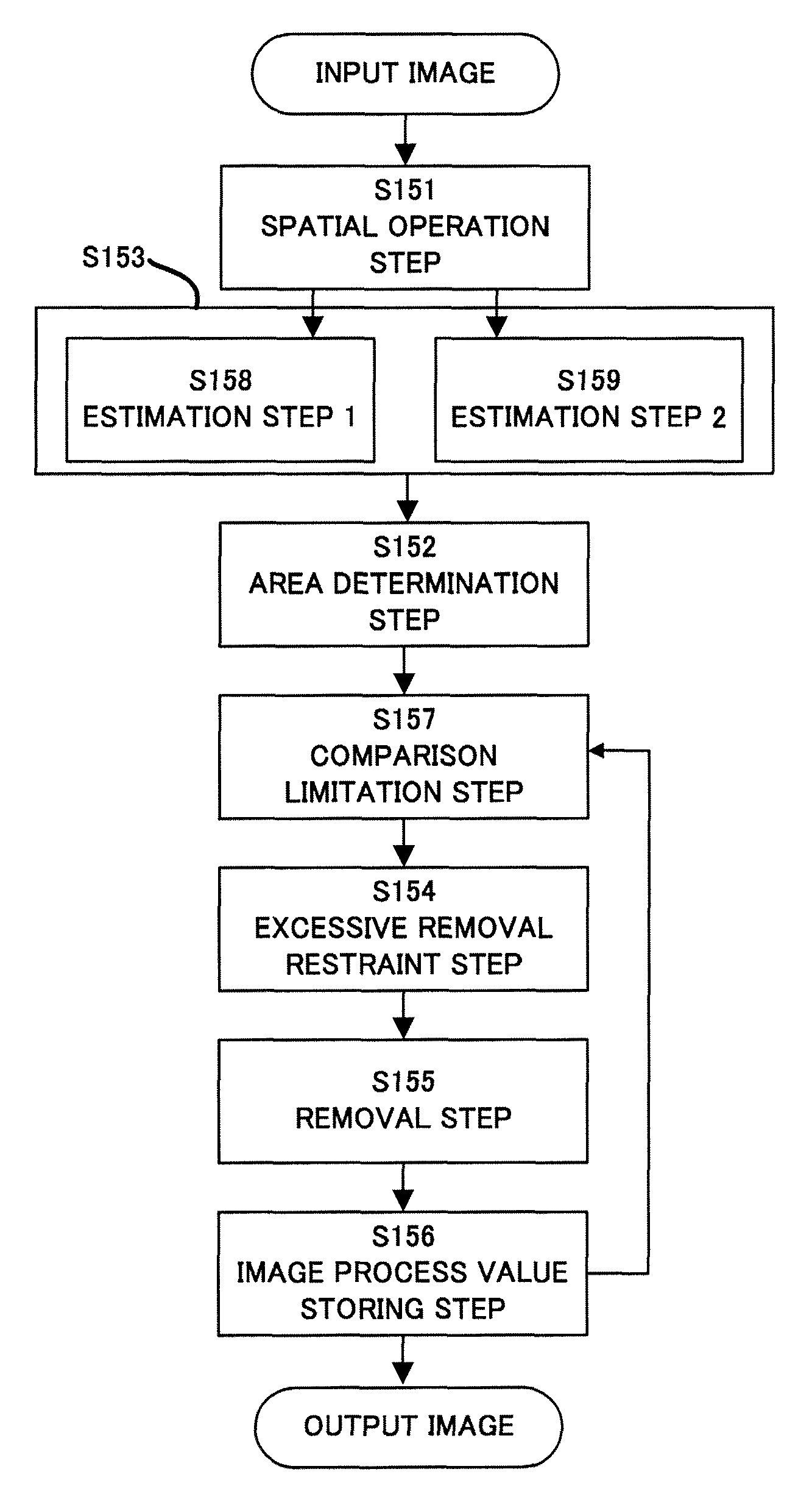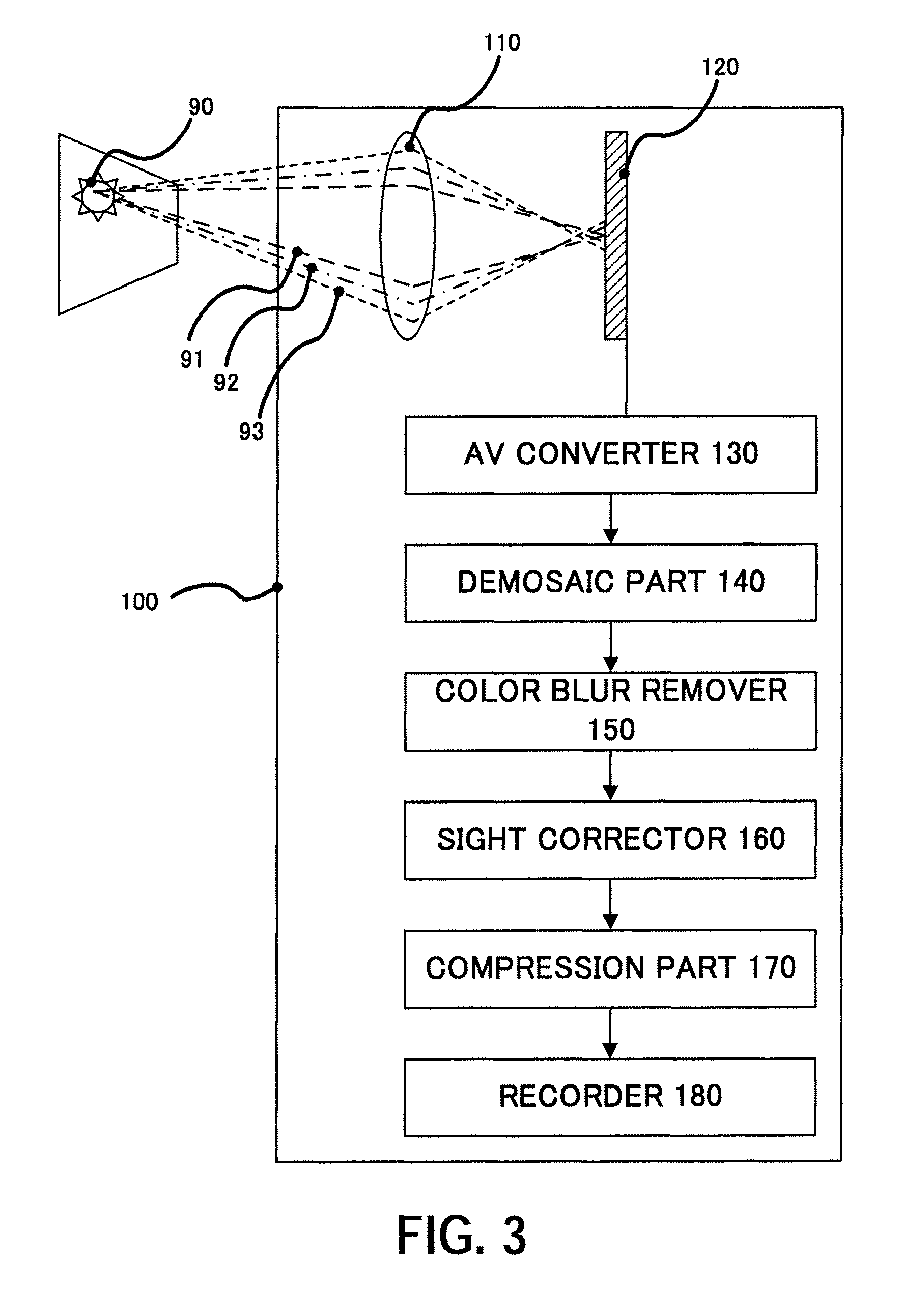Image processing apparatus and image processing method
a technology of image processing apparatus and image processing method, which is applied in the direction of picture signal generators, solid-state device signal generators, television systems, etc., can solve the problems of difficult to obtain the precise aberration function necessary to obtain a proper, and the difficulty of reducing chromatic aberration only by optics, so as to reduce unnatural effects and reduce color blur
- Summary
- Abstract
- Description
- Claims
- Application Information
AI Technical Summary
Benefits of technology
Problems solved by technology
Method used
Image
Examples
first embodiment
[0036]FIG. 3 shows a color image pickup apparatus 100 that utilizes an image processing method or is mounted with an image processing apparatus according to a first embodiment of the present invention.
[0037]The color image pickup apparatus 100 includes an imaging optical system 110, an image sensor 120, an AD converter 130, a demosaic part 140, a color blur remover 150, a sight corrector 160, a compression part 170, and a recorder 180.
[0038]Although a view field (imaging area or subject) shown in FIG. 3 and an R (red) ray 91, a G (green) ray 92, and a B (blue) ray 93 are not the elements of the color image pickup apparatus 100, they are illustrated for description purposes.
[0039]In FIG. 3, the taken view field 90 is imaged on the image sensor 120 via the imaging optical system 110. In general, an imaging optical system in a color image pickup apparatus is provided with a certain chromatic aberration correction. The longitudinal chromatic aberration of the imaging optical system 110 ...
second embodiment
[0097]Next follows a description of a second embodiment according to the present invention. The first embodiment restricts the color blur estimation amount E, whereas this embodiment restricts the B plane intensity after the color blur estimation amount is removed (or the image pixel value of the second frame image after the color blur reduction). Therefore, the process performed by the color blur remover 150 in the color image pickup apparatus shown in FIG. 3 is different from the first embodiment.
[0098]Referring to a flowchart of FIG. 12, a description will be given of a process of the color blur remover 150 of this embodiment. The color blur remover 150 includes a spatial operation step 1151, an estimation step 1153, an area determination step 1152, a removal estimation step 1158, a comparison limitation step 1157, an excessive removal restraint step 1154, a removal step 1155, and an image process value storing step 1156.
[0099]The above steps 1151 to 1158 can be regarded as the e...
third embodiment
[0114]Next follows a description of a third embodiment according to the present invention. This embodiment discusses an example that changes, based on a spatial operation result, the lower and upper limit values used to restrict the color blur estimation amount described in the first embodiment.
[0115]A point 906 shown in FIGS. 9A-9C is closer to the high brightness subject 901, and has a greater color blur estimation amount than the point 905. When the lower and upper limit values used to restrict the color blur estimation amount are made constant in an image, as understood from a comparison between the B plane intensity 1401 before the color blur removal and the B plane intensity 1402 after the removal shown in FIG. 14, a color blur can be sufficiently removed from the point 905 having a smaller color blur than the upper limit value. However, the color blur cannot be sufficiently eliminated from the point 906 having a color blur that exceeds the upper limit value, and may bring a s...
PUM
 Login to View More
Login to View More Abstract
Description
Claims
Application Information
 Login to View More
Login to View More - R&D
- Intellectual Property
- Life Sciences
- Materials
- Tech Scout
- Unparalleled Data Quality
- Higher Quality Content
- 60% Fewer Hallucinations
Browse by: Latest US Patents, China's latest patents, Technical Efficacy Thesaurus, Application Domain, Technology Topic, Popular Technical Reports.
© 2025 PatSnap. All rights reserved.Legal|Privacy policy|Modern Slavery Act Transparency Statement|Sitemap|About US| Contact US: help@patsnap.com



